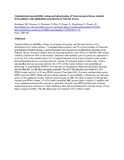Antimicrobial susceptibility testing and phenotyping of Neisseria gonorrhoeae isolated from patients with ophthalmia neonatorum in Nairobi, Kenya
Date
1985-09Author
Brunham, RC
Fransen, L
Plummer, F
Piot, P
Slaney, L
Bygdeman, S
Nsanze, H
Type
ArticleLanguage
enMetadata
Show full item recordAbstract
Antimicrobial susceptibility testing, auxotyping-serotyping, and plasmid analysis were performed on 41 ocular isolates, 7 nasopharyngeal isolates, and 18 cervical isolates of Neisseria gonorrhoeae obtained during a recent treatment trial of gonococcal ophthalmia neonatorum in Nairobi, Kenya. Fourteen distinct serovar-auxotype patterns were observed with IB-1/Pro-strains which accounted for 59% of the isolates. Infection with multiple types of gonococci appeared to occur in 22% of the mothers since 4 of 18 paired maternal cervical and neonatal ocular isolates had mismatched serovar-auxotype patterns. Among 10 treatment failure isolates only 1 had a mismatched serovar-auxotype pattern. Six (15%) of the ocular isolates were penicillinase-producing N. gonorrhoeae (PPNG). Five had the 4.4-megadalton (Md) beta-lactamase plasmid and one had the 3.2-Md beta-lactamase plasmid. The 24.5-Md plasmid was found in 5 of 6 PPNG strains and in 8 of 35 non-PPNG strains (P less than 0.02). For most antimicrobial agents, PPNG and non-PPNG strains showed similar patterns of susceptibility. Ceftriaxone was the most active of the antibiotics tested, with all strains having an MIC less than or equal to 0.06 mg/liter. Among non-PPNG strains, 15 (43%) had a penicillin MIC greater than or equal to 2 mg/liter and were considered intrinsically resistant to penicillin. Overall, non-PPNG intrinsically resistant strains had greater resistance to other antibiotics than did non-intrinsically resistant strains (P less than or equal to 0.006). The Mtr phenotype was found in 53% of these strains.
URI
http://www.ncbi.nlm.nih.gov/pubmed/3935043http://erepository.uonbi.ac.ke:8080/xmlui/handle/123456789/31176
Citation
Antimicrob Agents Chemother. 1985 Sep;28(3):393-6.Publisher
University of Nairobi, Department of Medicine
Collections
- Faculty of Health Sciences (FHS) [10377]

